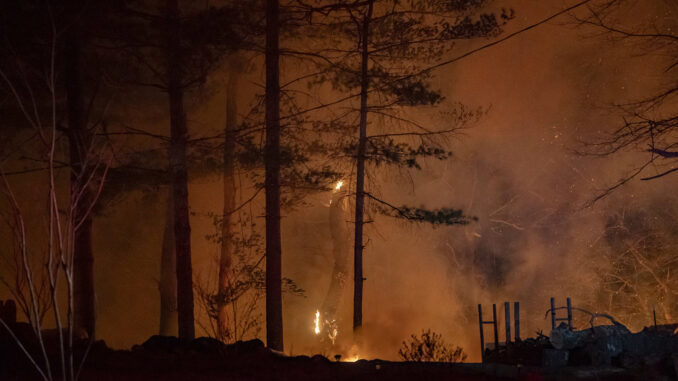

RALEIGH — Firefighters announced progress Wednesday night on containing two of the largest wildfires burning in the North Carolina mountains, but they warned that fire danger remained from dry and windy conditions.
The news was worse in South Carolina, where two fires nearly doubled in size Wednesday, but crews kept the blazes away from homes and other structures.
Hundreds of people have been asked to leave their homes in North Carolina and South Carolina as a half-dozen large fires are burning in the Blue Ridge Mountains, spreading smoke into places like Greenville. Millions of fallen trees from September’s Hurricane Helene are both providing fuel for the wildfires and hindering firefighters’ use of logging roads and paths.
About 250 homes have been evacuated in Polk County, where the fires are centered. About two dozen homes and outbuildings have been destroyed in Polk County, spokesperson Kellie Cannon said.
Fire officials in North Carolina have asked citizens in the affected areas to check the Polk County and Henderson County websites for evacuation news and notices. Polk County has numerous localities under Level 3, a mandatory evacuation situation.
Firefighters have managed to save most of the structures near the fires. Only one injury has been reported — a firefighter in North Carolina got his leg caught under a tree, officials said.
North Carolina fire update
Wednesday’s dry weather led to several new fires in western North Carolina and prompted Gov. Josh Stein to declare a state of emergency in 34 western counties. At least nine fires were active in that part of the state, officials said.
“Our State Emergency Response Team is responding with every tool at its disposal. Please stay safe and stay alert for any evacuation orders if the fires spread to an area near you,” Stein said in a statement.
Late Tuesday, a wildfire started in far western North Carolina not far from Bryson City. Police were evacuating dozens of people as the fire spread to nearly 1 square mile.
The N.C. Forest Service released a map of the perimeters of the fires in Black Cove, Deep Woods and Fish Hook on Wednesday afternoon. Per yesterday evening’s update Black Cove Fire was 3,052 acres in size and 17% contained, Deep Woods Fire was 3,231 acres in size and 11% contained, and Fish Hook Fire was 199 acres in size and 86% contained.
The fires have scorched nearly 10 square miles combined, but the size of the area burned has largely remained the same since the previous day.
Both the Black Cove and Fish Hook fires were started by downed power lines. The Deep Woods fire’s origin is still under investigation.
South Carolina fire update
South Carolina fire officials called for their first round of evacuations Tuesday night and more throughout the day Wednesday.
Two fires are burning — a larger one inside Table Rock State Park in Pickens County that has consumed 7.1 square miles and another one on Persimmon Ridge in Greenville County that has burned 2.4 square miles, according to measurements from the air Wednesday afternoon. Officials said the fires have likely grown since then.
About 250 homes are in the Pickens County evacuation zone with more in neighboring Greenville County, authorities said.
The fires are about 8 miles apart, and winds are strong enough that authorities decided to evacuate the area between the two fires.
Authorities tell people to stop burning
North Carolina issued a statewide open burn ban effective 8 a.m. last Friday. All burning permits have been rescinded and no new permits are being issued. The burn ban will stay in effect until further notice.
On Wednesday afternoon, North Carolina Gov. Josh Stein issued a state of emergency.
“The State Emergency Response Team is on the ground assisting affected counties and has been since late last week,” Stein said on X. “We are still under a statewide burn ban. I continue to urge residents to pay close attention to local emergency alerts and evacuation notifications.”
The State of Emergency in North Carolina includes the following counties: Alexander, Alleghany, Ashe, Avery, Buncombe, Burke, Cabarrus, Caldwell, Catawba, Cherokee, Clay, Cleveland, Gaston, Graham, Haywood, Henderson, Iredell, Jackson, Lincoln, Macon, Madison, McDowell, Mecklenburg, Mitchell, Polk, Rowan, Rutherford, Stanly, Swain, Transylvania, Union, Watauga, Wilkes, Yancey and tribal lands in the State of North Carolina held by the Eastern Band of Cherokee Indians.
The fires in South Carolina have been caused by humans. WBTV News has reported four teens have been accused of starting the fire in the Table Rock State Park area.
Authorities from local fire chiefs all the way to South Carolina’s governor are urging people to heed burn bans in both states and stop setting fires at campsites or to burn garbage.
“We have people going out in the woods and in their backyards and starting fires when the wind is blowing and everything is dry,” South Carolina Gov. Henry McMaster said. “We just have to use common sense. People get out in nature and they forget how dangerous it can be.”
Discouraging forecasts
There is rain in the forecast for the weekend, but it isn’t the kind of soaking downpour that can knock a fire out on its own, said National Weather Service meteorologist Ashley Rehnberg in Greer, South Carolina.
“Hopefully that will at least calm things down briefly,” Rehnberg said.
The bright spot in the forecast for the next week is there is no especially dangerous day where the winds and the dry weather reach potentially disastrous levels like in Los Angeles in January or Gatlinburg, Tennessee, in 2016.
Forestry agencies in North Carolina and South Carolina are already figuring out how to rotate teams of firefighters into and out of the mountains for what could be a long fight.
“Burn bans are in place, and people need to follow them,” Rehnberg said. “Even if we do get rain, the weather is going to continue to be a problem as far as we can forecast.”
North State Journal’s A.P. Dillon contributed to this report.



